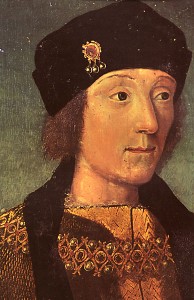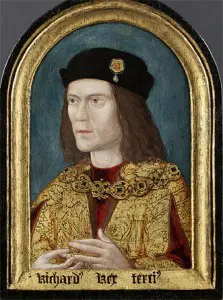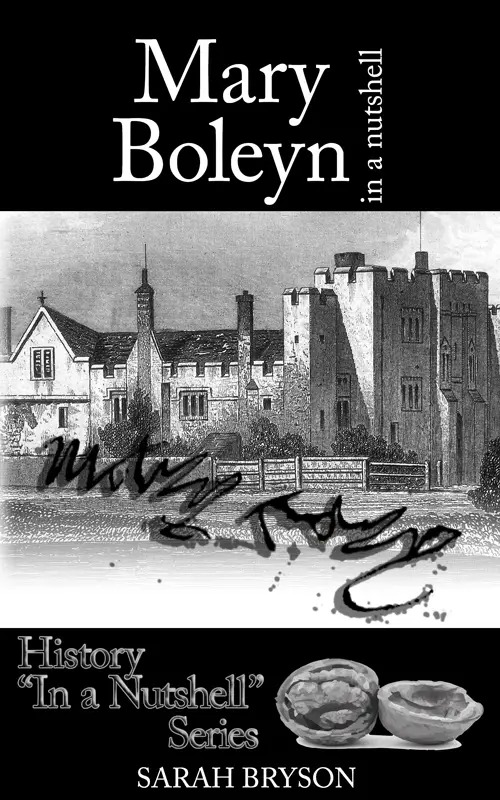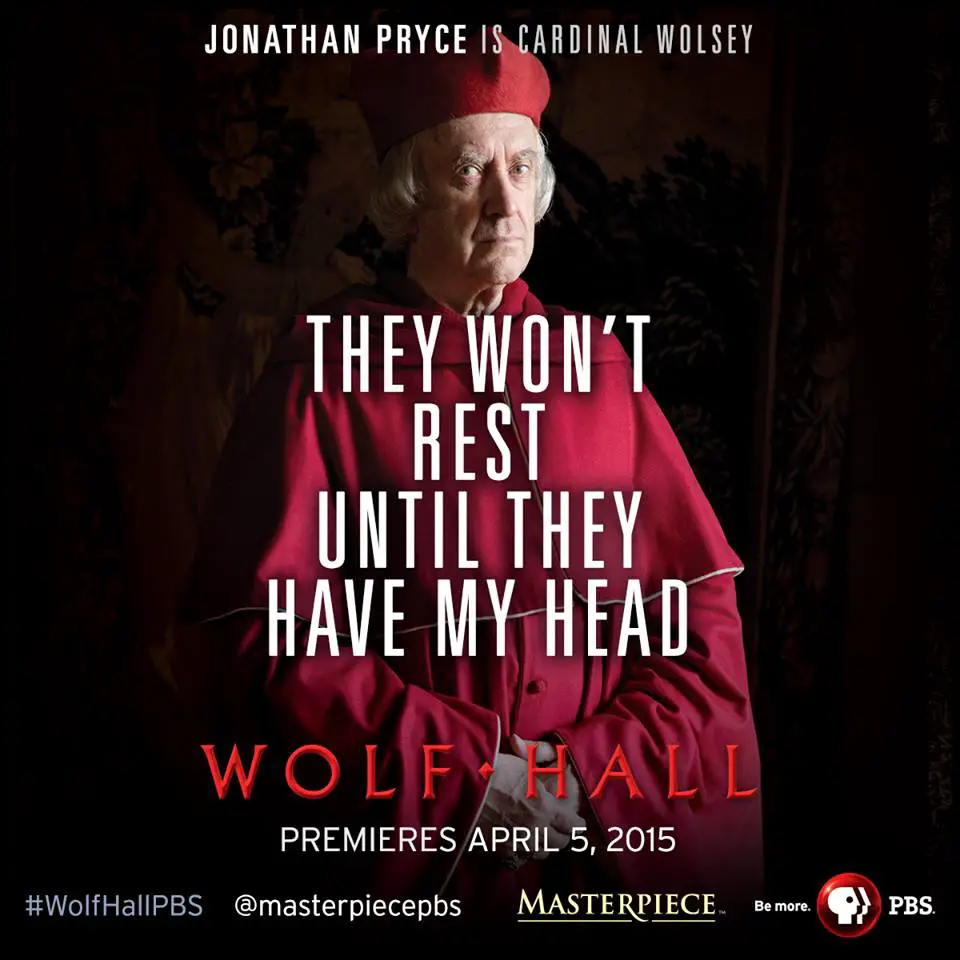
Henry VII
The Battle of Bosworth has gone down in record as one of the most pivotal battles in English history. The aftermath of the battle changed the course of England and saw a new monarch and dynasty come to the throne.
The 1st of August 1485 was to be the day that Henry Tudor would finally leave France after fourteen years of exile in Brittany and France aiming to lay claim to the English throne. He set sail from Harfleur, France accompanied by approximately 400 Englishmen, 800 Scots and approximately 1500 French troops. The exact number of French troops is hard to estimate as different reports record different numbers.
Landing on the 7th of August at Mill Bay, six miles west of Milford Haven, located along the Pembrokeshire coastline, it is said that when he reached the coast Henry knelt down and kissed the sand reciting Psalm 23 “Judge me , Oh God, and distinguish my cause”. He then made the sign of the cross. At Mill Bay Henry was met by his half uncle David Owen, illegitimate son of Owen Tudor, Henry’s grandfather. Gathering his men Henry headed off to lay claim to the English throne.
Their first stop was the village of Dale, whose castle surrendered easily. Henry and his men camped there and the future King made sure to remind his men not to get up to any trouble. The troops then moved on through Haverfordwest and Cardigan then northward to Llwyn Dafydd. After this, they claimed the garrison at Aberystwyth Castle and then turned to march inland. On 13th August they reached Machynlleth and the next day they made a thirty mile trek across rough terrain to Dolarddun. Following this, the growing army headed to Long Mountain where Henry met with Rhys ap Thomas, an important man who carried a great deal of sway with the Welsh people. Rhys pledged his loyalty to Henry and brought approximately 1800 – 2000 troops to Henry’s cause.
With his growing number of troops Henry then headed to Shrewsbury. However the portcullises were closed and Henry and his men were not given permission to pass. The next day Henry sent a messenger to negotiate with those in charge at Shrewsbury and Henry and his men were allowed to pass through and a number of men from the town joined Henry’s forces.
From Shrewsbury, Henry travelled through Shropshire and Staffordshire. It was at Staffordshire that Sir Gilbert Talbot and a troop of about 500 men joined with Henry. The men marched to Stafford where Henry would meet Sir William Stanley, younger brother of Henry’s step-father. Throughout this time, the Stanley’s had been sitting on the fence, not making their allegiances clear to either Henry or King Richard III. Although it is interesting to note that Thomas Stanley, Henry’s step-father, had been following Henry and his men under the pretence of keeping an eye on them for the King. In addition to this it was William Stanley that sent a message to the mayor of Shrewsbury to convince him to open the gates to Henry and his men. Had the Stanley brother’s allegiance already been decided?
From Stafford Henry and his men marched through Lichfield arriving at Tamworth on the 20th of August. The next day his men marched over the River Anker to Atherstone where Henry is reported to have had a secret meeting with his stepfather. It was at this meeting that allegedly Thomas Stanley pledged his formal support for his stepson.
However, the next day, on the 22nd of August, Henry sent a message to his step father asking him to send his men to join Henry’s troops. To this Stanley replied that he needed to prepare his men and for now it would appear he was keeping his distance.
There is great debate as to exactly where the Battle of Bosworth took place. There is also a great deal of debate as to how the battle played out and where Henry Tudor and Richard III’s armies were placed and deployed. It is estimated that Henry had an army of approximately five to eight thousand soldiers to King Richard III’s twelve or more thousand men. Thomas and William Stanley had a combined force of approximately six thousand men. However, neither brother had made a definitive move as to which side of the battle he would join. Richard III held the higher ground upon Ambion Hill while Henry and his men were on the lower ground next to marshes.
Henry Tudor, lacking experience in military action appointed the Earl of Oxford to command his troops and lead the Vanguard. Next to the vanguard was Henry, flanked by Gilbert Talbot and Sir John Savage and the rest of his men. Close to Henry was his friend William Brandon who had been chosen to be Henry’s standard bearer. The standard that Henry chose was white and green representing the Tudor colours. Upon this was the red cross of St George, patron saint of England and soldiers and the red Dragon of Wales. Henry Tudor had strong ties with Wales through his grandfather Owen Tudor as well as his uncle Jasper Tudor. This identification with Wales and its people helped Henry to recruit many Welsh men and soldiers along his campaign towards London.

Richard III
When the battle cry was called, arrows fired and then Oxford’s men clashed with the Duke of Norfolk’s. The sound of clashing metal, war cries and screaming must have filled the air, mixed with the smell of sweat and battle overwhelming the senses. It was during this initial battle that the Duke of Norfolk was killed. Both sides then paused, perhaps to regain their breath and positions. Oxford formed his men into a wedge and charged forward. At this second charge Henry’s French troops joined the battle and joined the attack on Norfolk’s men. Soon Norfolk’s men were in trouble and many were killed, others fled and some defected to Henry Tudor’s side.
Northumberland and his men did not move into the fight and it is believed that at some point the Earl decided to leave the battle without employing any of his men into the fray. Amongst the chaos some of his loyal supporters begged Richard III to flee but the King would be no coward. Oxford’s men had pushed forward leaving a gap. Seeing his gap Richard III saw an opportunity to get to his opponent and he and his men charged forward aiming to strike down Henry.
Reports have it that Richard III charged at Henry’s standard bearer with his lance, the lance piercing through Brandon and breaking in half. Tragically Brandon fell and was killed. Richard III and his men continued forward, the battle was fierce and heated and Henry, with little support must have feared for his life. However it was now the Stanley brothers who had been watching the battle up to this point decided to act. William Stanley and his men charged down in support of Henry Tudor and the armies clashed. It was at some point during this battle that Richard III was killed. Despite history recording him as a hunchback and a coward, Richard III fought bravely until his final breath.
After the battle, Henry was declared victorious. He ordered that the dead and wounded be tended to. Many of those that died were buried at the nearby church of St James. After fourteen years in exile, having marched halfway across Wales and England in just two weeks and then being vastly outnumbered, Henry Tudor and his men went against insurmountable odds and won. Within just two short hours, the man who had tenuous ties to the throne had defeated a King and claimed the crown for himself. From Bosworth, Henry and his men marched to London where Henry Tudor was crowned King Henry VII on 30th October 1485 and the dynasty of the Tudors began.
If you're a Tudor Society member then you can enjoy the following articles on the Battle of Bosworth from Tudor Life magazine:
- Bosworth's Lost Commander by Susan Fern - see March issue at https://www.tudorsociety.com/march-2015-tudor-life-magazine/
- Henry Tudor, Richard III and the Stanleys by Mike Ingram - see December issue at https://www.tudorsociety.com/tudor-life-december-2014/
- Bosworth: The Day the Tudors Came by Mike Ingram - see January issue at https://www.tudorsociety.com/tudor-life-january-2015/
Sarah Bryson is the author of Mary Boleyn: In a Nutshell. She is a researcher, writer and educator who has a Bachelor of Early Childhood Education with Honours and currently works with children with disabilities. Sarah is passionate about Tudor history and has a deep interest in Mary Boleyn, Anne Boleyn, the reign of Henry VIII and the people of his court. Visiting England in 2009 furthered her passion and when she returned home she started a website, queentohistory.com, and Facebook page about Tudor history. Sarah lives in Australia, enjoys reading, writing, Tudor costume enactment and wishes to return to England one day.
Sources
- Bayani, Debra (2015) Jasper Tudor Godfather of the Tudor Dynasty, MadeGlobal Publishing.
- Chronicles of England, Scotland, and Ireland 2015, The Holinshed Project, viewed 16th January 2015, http://www.cems.ox.ac.uk/holinshed/index.shtml.
- De Lisle, Leanda (2013) Tudor The Family Story, Chatto & Windus, London.
- Ingram, Mike (2015) ‘Bosworth The Day The Tudors Came’, Tudor Life, vol. 5, pp. 2-7.
- Jokien A 2010, The Battle of Bosworth Field, Luminarium Encyclopaedia Project, viewed 16th January 2014, http://www.luminarium.org/encyclopedia/bosworth.htm.
- Johnson, B (2015) The Red Dragon of Wales, Historic UK, viewed 16th January 1015, http://www.historic-uk.com/HistoryUK/HistoryofWales/The-Red-Dragon-of-Wales/.
- Loades, David (2012) The Tudors History of a Dynasty, Continuum International Publishing Group, London.
- Merriam-Webster Incorporated 2015, Standard-bearer, An Encyclopaedia Britannica Company, viewed 1th January 2015, http://www.merriam-webster.com/dictionary/standard-bearer.
- Penn, Thomas (2011) Winter King: The Dawn of Tudor England, Penguin Group, London.
- The Battle of Bosworth 2014, History Learning Site, viewed 16th January 2015, http://www.historylearningsite.co.uk/battle_of_bosworth.htm.
- Thorton, M. The Battle of Bosworth, viewed 16th January 2015, http://battlefield-site.co.uk/bosworth.htm.
- UK Battlefields Resource Centre 2015, Battle of Bosworth, The Battlefield Trust, viewed 16th January 2015, http://www.battlefieldstrust.com/resource-centre/warsoftheroses/battleview.asp?BattleFieldId=8>



Wonderful article Sarah!!! By chance do you know what town is “six miles west” of Milford Haven? Haverfordwest perhaps? If there is someone from Wales who could answer this, I would really appreciate it. My mum is from Milford, so I want to “enlighten” her. My grandfather always boasted that King Henry VII landed in Milford, so she would find this interesting.
The nearest place to Mill Bay, where Henry VII landed, is the village of Dale – see http://en.wikipedia.org/wiki/Dale,_Pembrokeshire.
Thank you!!!
Excellent piece of historical research and data. It certainly begs the question of how things might have been if the Stanley’s hadn’t decided to support Henry. Maybe they decided to back what they saw as the imminent loser. However, the few years that Richard did rule proved that he probably would have introduced improvements for the people, and that he would not have ruled by menace and fear.
I wish this sort of academic research and information was available when I did history at school. How thought provoking and fascinating the subject would have been and how much more engrossed the pupils..
I have noticed you don’t monetize your site, don’t waste your traffic, you can earn additional cash every month because you’ve got high quality content.
If you want to know how to make extra $$$, search
for: Mertiso’s tips best adsense alternative
Excellent piece of writing. In fact it is the best description of events that I have read. I have managed to follow the arrival of Henry on the map which has given me a greater insight of how he amassed so many troops and the route he took. information I had hitherto been unaware of.